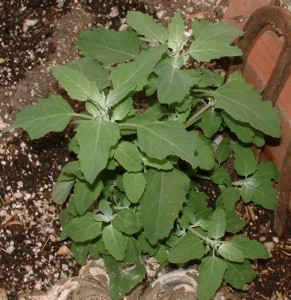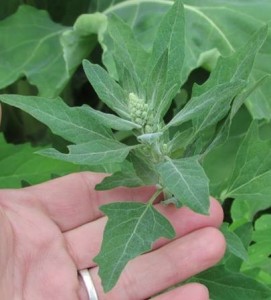During WWll, the American Government considered garden weeds to be good nutritious food. Some of the top weeds at that time included Amaranth and Lamb’s Quarters. Not only are they nutritious but they grow incredibly fast! Currently farmers across America are experiencing a phenomenon known as “superweeds” and one of those causing a great deal of trouble is Amaranth AKA Pigweed. There are 60-70 different species of Amaranth that can be found almost anywhere, but the Palmer Amaranth specifically has become resistant to the popular weed killer Roundup. This particular species can easily grow up to 18 feet tall or more and stop a combine dead in its tracks. This is no surprise really, when you consider we now have “superbugs” as a result of antibiotic overuse. Glyphosate, the main ingredient in Roundup is classified as an antibiotic and millions of tons of it are used on factory farms every year. Unfortunately the strategy to combat the issue of superweeds is to add more herbicides. Coming from a historical viewpoint, I don’t think that’s going to work.
Per a survey conducted by Stratus Agra-Marketing, “The area of U.S. cropland infested with glyphosate-resistant weeds has expanded to 61.2 million acres in 2012. Nearly half (49%) of all U.S. farmers interviewed reported that glyphosate-resistant weeds were present on their farm in 2012, up from 34% of farmers in 2011. The survey also indicates that the rate at which glyphosate-resistant weeds are spreading is gaining momentum, increasing 25% in 2011 and 51% in 2012.”
See more here: farmindustrynews.com
It sparks the question, why don’t we just eat the weeds? The ironic reality is this, Amaranth is one of the most nutritious plants on the planet; by far exceeding the nutrient value of the crops the farmers are trying to protect from it. We certainly wouldn’t have a shortage of food if we were seeing value in our weeds instead of trying to control them with toxic chemicals. It seems to me that Nature is trying very hard to give us a wake-up call.
Considered sacred to the pre-Columbian Aztecs, Amaranth has been cultivated for thousands of years. Cousin to the spinach, it is eaten as a vegetable as well as used for its grain. Being very versatile, one plant can produce 50,000 or more seeds that can be sprouted, popped like popcorn, toasted or soaked and eaten raw. Amaranth is high in protein, has 2 essential amino acids that most grains don’t have; lysine and methionine. It’s 3 times higher in fiber than wheat and like wheat can be ground into flour. It can be made into bread and can even be used to make beer! It provides calcium, iron, potassium, phosphorus, vitamins A, C and E.
Amaranth prefers to grow in full sun, in rich to poor soil as long as moisture is available. Found around and in gardens, disturbed areas and vacant lots. Although considered an opportunist, it will not grow in shade. Found throughout most of the Americas as well as the rest of the world.
Amaranth Leaves
| Amount of nutrients per 100 gm Approx ½ cup | Calories 35 | |
| Water 91.6 gm | Calcium 448 mg | Beta Carotene 4300 ug |
| Protein 2.9 gm | Phosphorus. 85 mg | Thiamin 65 ug |
| Fat .4 gm | Iron 13 mg | Riboflavin 300 ug |
| Carbs 4.5 gm | Sodium 20 mg | Niacin 1300 ug |
| Fiber 1.1 gm | Potassium 617 mg | |
| Ascorbic Acid 53 mg |
ug = micrograms
Amaranth Seeds
| Amount of nutrients per 100 gm Approx ½ cup | Calories 358 | |
| Water 12.3 gm | Calcium 247 gm | Beta Carotene 0 ug |
| Protein 12.9 gm | Phosphorus 500 mg | Thiamin 140 ug |
| Fat 7.2 gm | Iron 3.4 mg | Riboflavin 320 ug |
| Carbs 65.1 gm | Sodium 33.5 mg | Niacin 1000 ug |
| Fiber 6.7 gm | Potassium 52.5 mg | |
| Ascorbic Acid 3 mg |
- If you are going to eat amaranth seeds soak them over night in water to reduce their saponin content.
- If Amaranth is fertilized heavily or grows in drought conditions it can hold a lot of nitrates.
Lamb’s Quarters
Almost everywhere I go I see this plant growing in abundance. One Lamb’s Quarter plant can provide plenty of food for one person throughout the summer simply by pinching the tops and allowing a couple of days before pinching again. Time and again when I ask people if they eat it, the response is the same, “What? NO! I pull it out!” Another relative of spinach, Lamb’s quarters are also referred to as wild spinach only they are much more nutritious. Once people realize the benefits of the plant comes the next question, “how do I eat it?” Short answer is put it in your mouth and chew. Many of the leafy weeds can be hung to dry, blanched and frozen for later use, boiled, sautéed or simply steamed as a vegetable. I like to stir fry mine with quinoa or rice to give it a tasty and nutritious boost as well as adding it to my salads.
All parts of this plant may be used as a poultice for swelling, rheumatism or arthritis. Dried and powdered, it can be added to gelatin capsules to make a potent, inexpensive vitamin.
Lamb’s Quarters Shoots (young leaves)
| Amount of nutrients per 100 gm Approx ½ cup | Calories 35 | |
| Water 88.0 gm | Calcium 324 mg | Beta Carotene 3800 ug |
| Protein 3.5 gm | Phosphorus 48 mg | Thiamin 100 ug |
| Fat 0.8 gm | Iron 1.5 mg | Riboflavin 200 ug |
| Carbs 5.5 gm | Sodium 4 mg | Niacin 1000 ug |
| Fiber 2.0 gm | Potassium 684 mg | |
| Ascorbic Acid 40 mg |
Lamb’s Quarters Seeds
| Amount of nutrients per 100 gm Approx ½ cup | Calories 35 | |
| Water 8.3 gm | Calcium 1036 mg | Beta Carotene 0 ug |
| Protein 19.6 gm | Phosphorus 340 mg | Thiamin 450 ug |
| Fat 4.2 gm | Iron 64 mg | Riboflavin 200 ug |
| Carbs 57.7 gm | Sodium 9 mg | Niacin 3800 ug |
| Fiber 27.1 gm | Potassium 1687 mg | |
| Ascorbic Acid 0 mg |
Take a look at those numbers folks. ½ cup of seeds can provide serious energy and take up a very small space in your back pack. With as much calcium as 6 glasses of milk and being bio-available it’s much easier to assimilate than calcium from milk without the added hormones and antibiotics. The seeds are also important food for wild birds.
Benefits of eating wild food
Wild foods are nutritious, abundant, free of cost, GMO free, and at least 7-10 times more nutritious than their domesticated relatives.
You will never be separated from your food supply. You can literally step out the back door and have a meal growing that can produce enough food to last the entire winter and into the next year.
They are still alive. Many of the organic vegetables in the grocery store are shipped half way around the world. By the time they reach their destination, little if any life force is left in them.
You’ll save money twofold. First on store bought leafy green vegetables and secondly on weed killer.
**Nutrient counts taken from The Essential Wild Food Survival Guide by Linda Runyon and are not a complete representation of the full scope of nutrients.
Mari Marques is a Certified Herbalist and owner of The Thymekeeper. For questions or more information contact: Mari at mugsyspad@aol.com or 719-439-7303. Mari is available for private consultation or to meet with you and see what’s blooming on your property in July and August.
Let’s take a walk in the woods!
July 11, 12 & 13 from 1:00-3:30 we’ll be leading herb walks on National Forest land. We’ll meet at 1870 County Road 31 in Florissant and carpool or drive to the site. July is the best time to see the many wild plants in bloom and this year with all the moisture they should be plentiful. Come prepared with enough water, snacks, rain gear and bug repellent. These walks are funded by donation. Pre-register with Mari at mugsyspad@aol.com


Leave a Reply